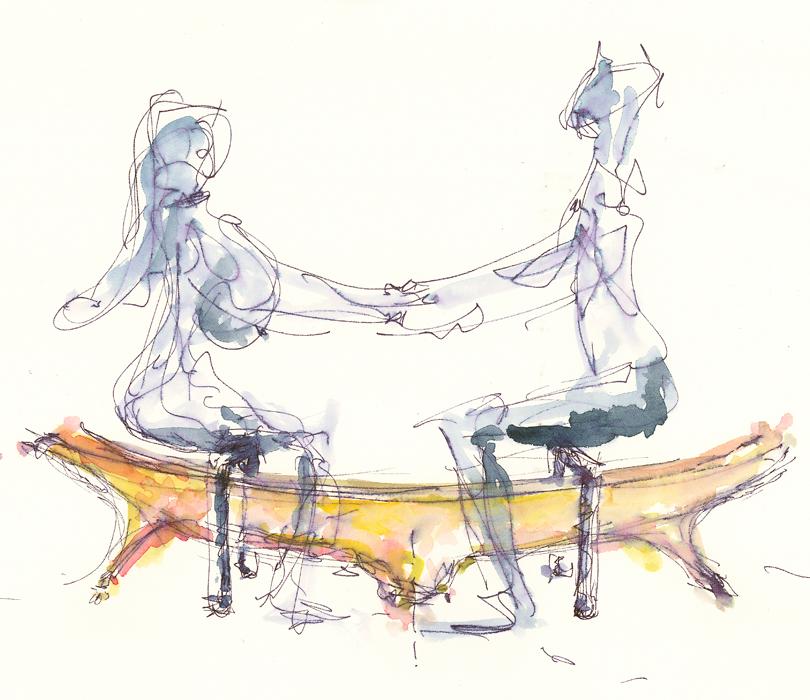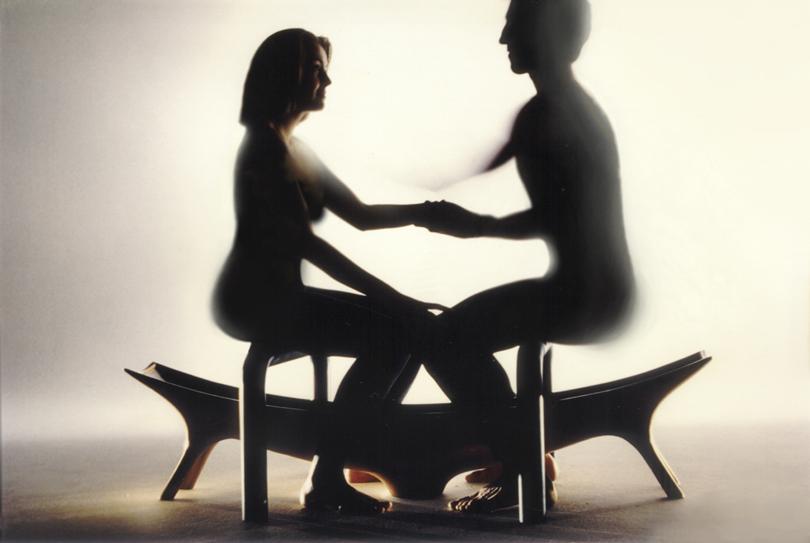interior & product design
Bicesso
Prototipo
Il Bicesso, progettato per l’Italia’s Cup (Triennale di Milano, 1989), sul tema “La coppia – The couple”, verte su un’ambigua eleganza, su un potenziamento di senso: va incontro e, nello stesso tempo, sovverte le attese.
Finalizzato ad un recupero di umanità, in rapporti semplici ed ingenui, prevede di venire utilizzato, per mingere e defecare, da Lui e da Lei, in un medesimo istante, in stretta ed intima contiguità.
Sul versante utopico, pretende di rilanciare l’amore tra la coppia moderna, a mezzo di un ricorso alla sinestesia, ad un uso totale ed innocente delle sensazioni e dei sentimenti: vera fusione di anime belle e di corpi.
Di fronte al Bicesso, superata una prima immancabile reazione negativa, l’ironia cede al sorriso: al sorriso d’una creatura terrestre che intravede, di nuovo, come possibile l’accesso al territorio d’una perduta felicità.
Nel pensare al Bicesso, nel disegnarlo, nel modellarlo in creta di Castellamonte prima e poi in polistirolo e gesso per lo stampo, avevo coscienza della linea sottile che divide negazione-affermazione, rifiuto-accoglienza: ho scommesso sulla possibilità di accedere all’io profondo, sebbene condizionato dalla società moderna, risvegliandovi istanze di purezza, di pulizia, nelle relazioni tra maschio e femmina, tramite amore, come nelle splendide miniature gotiche che ritraggono i nostri progenitori sullo sfondo di vividi boschetti, nello zampillare armonioso di acque.
Mi ha assistito, nei momenti di sconforto, l’aiuto della sensibilità orientale, che sintetizzo in una citazione “… riuscirono a trasformare il luogo della casa che, per sua destinazione, avrebbe dovuto essere più sordido, in una cella consacrata all’elezione e alla squisitezza del gusto, immersa nella natura, avvolta da una bruma di immagini e reminiscenze delicate. Al contrario, gli Occidentali hanno deliberato una volta per tutte che il gabinetto è sconveniente, e in società si astengono persino dal nominarlo. Quanto più savio è il nostro atteggiamento, o almeno più vicino all’intima verità delle cose!.” da Libro d’ombra di Junichiro Tanizaki.
Il Bicesso è un modo possibile d’incontro tra due persone, all’interno della società elettronica percorsa da flussi d’informazione che tendono allo straniamento e all’appiattimento. Si tratta di restituire significanza ad atti del quotidiano per trasferirli nell’ambito del meraviglioso, mediante il recupero dell’incidenza del rito nell’esistere umano a partire dal corpo e dalla sua proiezione in una recuperata totalità ed innocenza dei sensi.
Se ci si abbandona alla confidenza, in un’accezione più ampia del pudore, diventa accettabile una posizione che, per sua natura, sembrerebbe astratta, soltanto paradossale: durante le prove sul prototipo, superato un iniziale imbarazzo, atti e gesti di Lui e di Lei fluivano in modo gentile e dolce, per cui il Bicesso non si limita ad un’operazione di stile ma può accedere alla produzione di serie.
Il modello del Bicesso, dal lato della struttura, vinte le resistenze psicologiche che in noi derivano dalla repressione autoritaria della nudità promiscua dei corpi e dalla condanna di funzioni primarie, si compone di due parti: la scocca in vetroresina, poggiante su gambe, con scarico centrale, percorsa sul perimetro dal canale di lavamento; i supporti laterali ruotanti, in metallo.
La sua forma elegante, stretta ed allungata, possiede un potere di fascinazione, sporgendosi verso un’umanità rinnovata, più sicura perché, stracciando una rete di false convenzioni, ha saputo raggiungere una totale, intima accettazione di sé e del rapporto di coppia.
The Bicesso, designed for the Italia’s Cup (Triennale di Milano, 1989), on the subject "The couple", hinges on an ambiguous elegance, on a strengthening of feeling: it simultaneously meets and overturns expectations. Aimed at a recovery of humanity, in simple, candid relations, it is intended to be used for urinating and defecating, by he and she, at the same time, in close, intimate company. On a utopian level, it is intended to rekindle love between the modern couple, by means of recourse to synaesthesia, to a total and innocent use of feelings and emotions: a real blend of bodies and beautiful spirits. When confronted by the Bicesso, having got over a first inevitable negative reaction, irony gives way to smiling: the smile of a terrestrial creature that once again glimpses the possibility of access to the land of lost happiness.
In thinking about the Bicesso, in designing it, in shaping it in Castellamonte clay first and then in polystyrene and plaster for the mould, I was aware of the fine line that divides negation-affirmation, rejection-reception: I gambled on the possibility of accessing my deepest self, albeit influenced by modern society, to reawaken moments of purity, of cleanliness, in the relations between male and female, through love, like in the wonderful Gothic miniatures that portray our forebears against a background of bright forests, in the harmonious gushing of waters.
I was assisted in the difficult moments by oriental sensitivity, which I summarise in a quotation: ‘[…] they manage to transform the place in the house that should have been grubbier, given its purpose, into a cell consecrated to the election and delicacy of taste, immersed in nature, enfolded in a mist of images and delicate memories. On the contrary, Westerners have decided once and for all that the toilet is unseemly, and in society even refrain from naming it.
How much wiser is our attitude, or at least closer to the intimate truth of things!’, from Libro d’ombra by Junichiro Tanizaki. The Bicesso is a possible means for two people to meet, in an electronic society permeated by flows of information that tend toward alienation and levelling.
It is a question of returning significance to daily acts; transferring them into the sphere of the wondrous by recovering the impact of the rite on human existence, starting from the body and its projection in a recovered totality and innocence of the senses. If we abandon ourselves to intimacy, to a broader sense of modesty, a position that, by its nature, would seem abstract, only paradoxical, becomes acceptable.
During tests with the prototype, having got over an initial embarrassment, the acts and gestures of he and she flowed gently and sweetly, so the Bicesso is not restricted to an act of style but may lend itself to mass production. The model of the Bicesso, in terms of its structure, overcoming the psychological resistance that derives from the authoritarian repression of promiscuous nudity and the condemnation of primary functions, consists of two parts: the body in fibreglass, resting on legs, with central drain and flush channel around its perimeter; and revolving lateral supports, in metal. Its narrow, elongated, elegant form has a certain fascination, lending itself to a renewed, more certain humanity, because, tearing up a network of false conventions, it has managed to reach a total, intimate acceptance of itself and the relationship of the couple.


